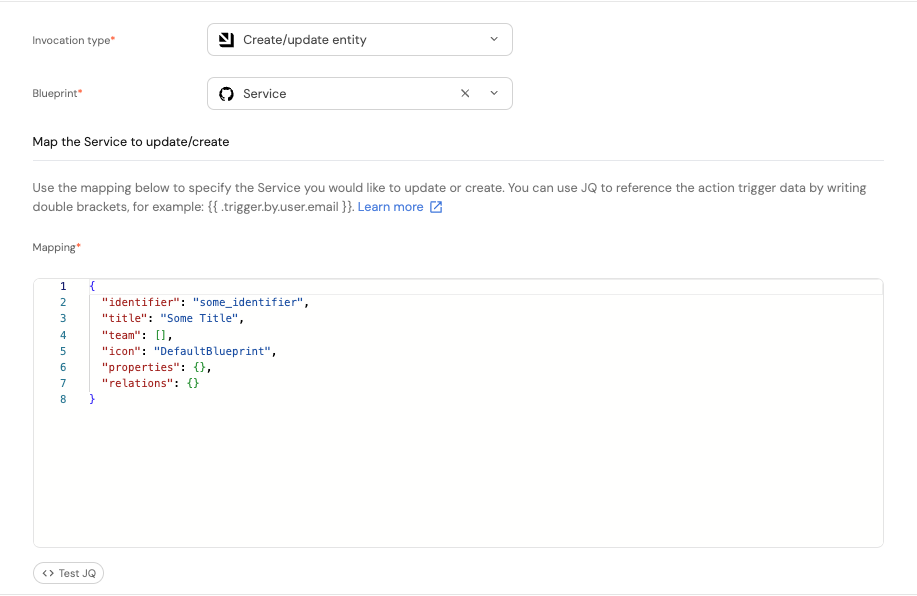Create/update entity
In some cases, we don't want to run complex logic via a workflow or pipeline, but rather want our backend to simply create or update an entity in our software catalog.
This backend type does exactly that, simplifying the process and avoiding unnecessary complexity.
Define the backend
To use this backend type, you will need to define the following fields:

-
The
blueprintfrom which the entity will be created or updated. -
The mapping of the created/updated entity:
{
"identifier": "some_identifier",
"title": "Some Title",
"team": [],
"icon": "DefaultBlueprint",
"properties": {},
"relations": {}
}
The table below describes the fields in the JSON structure (fields in bold are required):
Field Description identifierUsed to identify the entity in your software catalog. If it already exists, the entity will be updated, otherwise it will be created. titleThe title of the entity. teamThe team/s this entity will belong to. iconThe icon of the entity. propertiesThe properties of the entity, in "key":"value"pairs where the key is the property's identifier, and the value is its value.relationsThe relations of the entity, in "key":"value"pairs where the key is the relation's identifier, and the value is the related entity's identifier (for single relations) or an array of identifiers (for many relations).
Use jq to map the entity
All fields in the mapping object can be mapped using jq expressions, by wrapping the value in double curly braces {{ }}.
For example, say we want to assign the initiator of the action to a new entity when it is created, we can take his email from the action run object and assign it to a property named assignee:
{
"identifier": "someTaskEntity",
"title": "Some Task",
"team": ["team1"],
"icon": "DefaultBlueprint",
"properties": { "assignee": "{{ .trigger.by.user.email }}" },
"relations": {}
}
You can use the Test JQ button in the bottom-left corner to test your mapping against the action's schema.
Mapping entity relations
When creating or updating entities, you often need to establish relations with other entities. The mapping approach depends on whether you're dealing with single or multiple entity inputs.
- Single Entity
- Array Entity
- Flexible Mapping
For a single entity relation, map the entity identifier directly:
{
"identifier": "myServiceEntity",
"title": "My Service",
"properties": {},
"relations": {
"domain": "{{ .inputs.domain }}"
}
}
When your action accepts array entity inputs, you need to extract the identifiers from the array using the map(.identifier) pattern:
{
"identifier": "myUserEntity",
"title": "My User",
"properties": {},
"relations": {
"skills": "{{ .inputs.skills | map(.identifier) }}"
}
}
When users select multiple entities from an entity array input, the input contains an array of entity objects. Each object includes both identifier and title properties, but relations can only reference entity identifiers.
For maximum flexibility, you can create a conditional mapping that handles both single entity and array entity inputs:
{
"identifier": "myProjectEntity",
"title": "My Project",
"properties": {},
"relations": {
"dependencies": "{{ .inputs.dependencies | if type == \"array\" then map(.identifier) else .identifier end }}"
}
}
This pattern automatically:
- Extracts identifiers from arrays when multiple entities are selected
- Uses the identifier directly when a single entity is selected
Common use cases
Here are some typical scenarios for mapping array relations:
Mapping skills to a user:
"relations": {
"skills": "{{ .inputs.selectedSkills | map(.identifier) }}"
}
Mapping team members to a project:
"relations": {
"members": "{{ .inputs.teamMembers | map(.identifier) }}"
}
Mapping dependencies between services:
"relations": {
"dependsOn": "{{ .inputs.dependencies | map(.identifier) }}"
}
Relations can only reference entity identifiers, not titles. Even though entity objects contain both identifier and title properties, you must always use .identifier when mapping to relations.